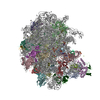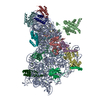[English] 日本語
 Yorodumi
Yorodumi- PDB-8cwo: Cutibacterium acnes 30S ribosomal subunit with Sarecycline bound,... -
+ Open data
Open data
- Basic information
Basic information
| Entry | Database: PDB / ID: 8cwo | ||||||
|---|---|---|---|---|---|---|---|
| Title | Cutibacterium acnes 30S ribosomal subunit with Sarecycline bound, body domain only in the local refined map | ||||||
 Components Components |
| ||||||
 Keywords Keywords | ANTIBIOTIC / ribosome / sarecycline / acne | ||||||
| Function / homology |  Function and homology information Function and homology informationribosomal small subunit biogenesis / small ribosomal subunit / small ribosomal subunit rRNA binding / cytosolic small ribosomal subunit / tRNA binding / rRNA binding / ribosome / structural constituent of ribosome / translation / ribonucleoprotein complex ...ribosomal small subunit biogenesis / small ribosomal subunit / small ribosomal subunit rRNA binding / cytosolic small ribosomal subunit / tRNA binding / rRNA binding / ribosome / structural constituent of ribosome / translation / ribonucleoprotein complex / cytoplasm / cytosol Similarity search - Function | ||||||
| Biological species |  Cutibacterium acnes (bacteria) Cutibacterium acnes (bacteria) | ||||||
| Method | ELECTRON MICROSCOPY / single particle reconstruction / cryo EM / Resolution: 2.84 Å | ||||||
 Authors Authors | Lomakin, I.B. / Devarkar, S.C. / Bunick, C.G. | ||||||
| Funding support |  United States, 1items United States, 1items
| ||||||
 Citation Citation |  Journal: Nucleic Acids Res / Year: 2023 Journal: Nucleic Acids Res / Year: 2023Title: Sarecycline inhibits protein translation in Cutibacterium acnes 70S ribosome using a two-site mechanism. Authors: Ivan B Lomakin / Swapnil C Devarkar / Shivali Patel / Ayman Grada / Christopher G Bunick /  Abstract: Acne vulgaris is a chronic disfiguring skin disease affecting ∼1 billion people worldwide, often having persistent negative effects on physical and mental health. The Gram-positive anaerobe, ...Acne vulgaris is a chronic disfiguring skin disease affecting ∼1 billion people worldwide, often having persistent negative effects on physical and mental health. The Gram-positive anaerobe, Cutibacterium acnes is implicated in acne pathogenesis and is, therefore, a main target for antibiotic-based acne therapy. We determined a 2.8-Å resolution structure of the 70S ribosome of Cutibacterium acnes by cryogenic electron microscopy and discovered that sarecycline, a narrow-spectrum antibiotic against Cutibacterium acnes, may inhibit two active sites of this bacterium's ribosome in contrast to the one site detected previously on the model ribosome of Thermus thermophilus. Apart from the canonical binding site at the mRNA decoding center, the second binding site for sarecycline exists at the nascent peptide exit tunnel, reminiscent of the macrolides class of antibiotics. The structure also revealed Cutibacterium acnes-specific features of the ribosomal RNA and proteins. Unlike the ribosome of the Gram-negative bacterium Escherichia coli, Cutibacterium acnes ribosome has two additional proteins, bS22 and bL37, which are also present in the ribosomes of Mycobacterium smegmatis and Mycobacterium tuberculosis. We show that bS22 and bL37 have antimicrobial properties and may be involved in maintaining the healthy homeostasis of the human skin microbiome. #1:  Journal: To be published Journal: To be publishedTitle: The structure of the Cutibacterium acnes 70S ribosome Authors: Lomakin, I.B. / Devarkar, S.C. / Grada, A. / Bunick, C.G. | ||||||
| History |
|
- Structure visualization
Structure visualization
| Structure viewer | Molecule:  Molmil Molmil Jmol/JSmol Jmol/JSmol |
|---|
- Downloads & links
Downloads & links
- Download
Download
| PDBx/mmCIF format |  8cwo.cif.gz 8cwo.cif.gz | 797.3 KB | Display |  PDBx/mmCIF format PDBx/mmCIF format |
|---|---|---|---|---|
| PDB format |  pdb8cwo.ent.gz pdb8cwo.ent.gz | 603.4 KB | Display |  PDB format PDB format |
| PDBx/mmJSON format |  8cwo.json.gz 8cwo.json.gz | Tree view |  PDBx/mmJSON format PDBx/mmJSON format | |
| Others |  Other downloads Other downloads |
-Validation report
| Summary document |  8cwo_validation.pdf.gz 8cwo_validation.pdf.gz | 1.7 MB | Display |  wwPDB validaton report wwPDB validaton report |
|---|---|---|---|---|
| Full document |  8cwo_full_validation.pdf.gz 8cwo_full_validation.pdf.gz | 1.8 MB | Display | |
| Data in XML |  8cwo_validation.xml.gz 8cwo_validation.xml.gz | 78.2 KB | Display | |
| Data in CIF |  8cwo_validation.cif.gz 8cwo_validation.cif.gz | 124.6 KB | Display | |
| Arichive directory |  https://data.pdbj.org/pub/pdb/validation_reports/cw/8cwo https://data.pdbj.org/pub/pdb/validation_reports/cw/8cwo ftp://data.pdbj.org/pub/pdb/validation_reports/cw/8cwo ftp://data.pdbj.org/pub/pdb/validation_reports/cw/8cwo | HTTPS FTP |
-Related structure data
| Related structure data |  27028MC  8crxC  8cvmC  8cvoC C: citing same article ( M: map data used to model this data |
|---|---|
| Similar structure data | Similarity search - Function & homology  F&H Search F&H Search |
- Links
Links
- Assembly
Assembly
| Deposited unit | 
|
|---|---|
| 1 |
|
- Components
Components
-RNA chain , 2 types, 2 molecules AY
| #1: RNA chain | Mass: 498742.875 Da / Num. of mol.: 1 / Source method: isolated from a natural source / Source: (natural)  Cutibacterium acnes (bacteria) / References: GenBank: 2179609306 Cutibacterium acnes (bacteria) / References: GenBank: 2179609306 |
|---|---|
| #15: RNA chain | Mass: 7115.308 Da / Num. of mol.: 1 / Source method: obtained synthetically / Source: (synth.)  |
-30S ribosomal protein ... , 13 types, 13 molecules DEFHKLOQRTPXB
| #2: Protein | Mass: 23271.605 Da / Num. of mol.: 1 / Source method: isolated from a natural source / Source: (natural)  Cutibacterium acnes (bacteria) / References: UniProt: A0A2B7JMY9 Cutibacterium acnes (bacteria) / References: UniProt: A0A2B7JMY9 |
|---|---|
| #3: Protein | Mass: 22603.695 Da / Num. of mol.: 1 / Source method: isolated from a natural source / Source: (natural)  Cutibacterium acnes (bacteria) / References: UniProt: A0A2B7I5L8 Cutibacterium acnes (bacteria) / References: UniProt: A0A2B7I5L8 |
| #4: Protein | Mass: 11270.147 Da / Num. of mol.: 1 / Source method: isolated from a natural source / Source: (natural)  Cutibacterium acnes (bacteria) / References: UniProt: A0A2C6L3A1 Cutibacterium acnes (bacteria) / References: UniProt: A0A2C6L3A1 |
| #5: Protein | Mass: 14677.930 Da / Num. of mol.: 1 / Source method: isolated from a natural source / Source: (natural)  Cutibacterium acnes (bacteria) / References: UniProt: A0A2B7ITQ7 Cutibacterium acnes (bacteria) / References: UniProt: A0A2B7ITQ7 |
| #6: Protein | Mass: 14194.463 Da / Num. of mol.: 1 / Source method: isolated from a natural source / Source: (natural)  Cutibacterium acnes (bacteria) / References: UniProt: A0A2B7I645 Cutibacterium acnes (bacteria) / References: UniProt: A0A2B7I645 |
| #7: Protein | Mass: 13666.084 Da / Num. of mol.: 1 / Source method: isolated from a natural source / Source: (natural)  Cutibacterium acnes (bacteria) / References: UniProt: A0A2C6LJN0 Cutibacterium acnes (bacteria) / References: UniProt: A0A2C6LJN0 |
| #8: Protein | Mass: 10102.760 Da / Num. of mol.: 1 / Source method: isolated from a natural source / Source: (natural)  Cutibacterium acnes (bacteria) / References: UniProt: A0A2B7I743 Cutibacterium acnes (bacteria) / References: UniProt: A0A2B7I743 |
| #9: Protein | Mass: 10475.277 Da / Num. of mol.: 1 / Source method: isolated from a natural source / Source: (natural)  Cutibacterium acnes (bacteria) / References: UniProt: A0A2B7JMS7 Cutibacterium acnes (bacteria) / References: UniProt: A0A2B7JMS7 |
| #10: Protein | Mass: 8817.497 Da / Num. of mol.: 1 / Source method: isolated from a natural source / Source: (natural)  Cutibacterium acnes (bacteria) / References: UniProt: A0A2C6LI71 Cutibacterium acnes (bacteria) / References: UniProt: A0A2C6LI71 |
| #11: Protein | Mass: 9724.277 Da / Num. of mol.: 1 / Source method: isolated from a natural source / Source: (natural)  Cutibacterium acnes (bacteria) / References: UniProt: A0A2B7I592 Cutibacterium acnes (bacteria) / References: UniProt: A0A2B7I592 |
| #12: Protein | Mass: 15980.861 Da / Num. of mol.: 1 / Source method: isolated from a natural source / Source: (natural)  Cutibacterium acnes (bacteria) / References: UniProt: A0A2B7IXM7 Cutibacterium acnes (bacteria) / References: UniProt: A0A2B7IXM7 |
| #13: Protein/peptide | Mass: 4120.248 Da / Num. of mol.: 1 / Source method: isolated from a natural source / Source: (natural)  Cutibacterium acnes (bacteria) / References: UniProt: A0A533INE0 Cutibacterium acnes (bacteria) / References: UniProt: A0A533INE0 |
| #14: Protein | Mass: 31583.166 Da / Num. of mol.: 1 / Source method: isolated from a natural source / Source: (natural)  Cutibacterium acnes (bacteria) / References: UniProt: A0A2B7I756 Cutibacterium acnes (bacteria) / References: UniProt: A0A2B7I756 |
-Non-polymers , 2 types, 67 molecules 


| #16: Chemical | ChemComp-MG / #17: Water | ChemComp-HOH / | |
|---|
-Details
| Has ligand of interest | N |
|---|
-Experimental details
-Experiment
| Experiment | Method: ELECTRON MICROSCOPY |
|---|---|
| EM experiment | Aggregation state: PARTICLE / 3D reconstruction method: single particle reconstruction |
- Sample preparation
Sample preparation
| Component | Name: 30S subunit body domain from 70S ribosome with mRNA, P-site tRNA and Sarecycline bound Type: RIBOSOME / Entity ID: #1-#15 / Source: NATURAL |
|---|---|
| Molecular weight | Experimental value: NO |
| Source (natural) | Organism:  Cutibacterium acnes (bacteria) Cutibacterium acnes (bacteria) |
| Buffer solution | pH: 7.4 |
| Specimen | Embedding applied: NO / Shadowing applied: NO / Staining applied: NO / Vitrification applied: YES |
| Vitrification | Instrument: FEI VITROBOT MARK IV / Cryogen name: ETHANE / Humidity: 100 % |
- Electron microscopy imaging
Electron microscopy imaging
| Experimental equipment |  Model: Titan Krios / Image courtesy: FEI Company |
|---|---|
| Microscopy | Model: FEI TITAN KRIOS |
| Electron gun | Electron source:  FIELD EMISSION GUN / Accelerating voltage: 300 kV / Illumination mode: FLOOD BEAM FIELD EMISSION GUN / Accelerating voltage: 300 kV / Illumination mode: FLOOD BEAM |
| Electron lens | Mode: BRIGHT FIELD / Nominal defocus max: 2000 nm / Nominal defocus min: 500 nm / Cs: 2.7 mm / C2 aperture diameter: 50 µm |
| Specimen holder | Cryogen: NITROGEN |
| Image recording | Average exposure time: 2.1 sec. / Electron dose: 30.56 e/Å2 / Film or detector model: GATAN K3 (6k x 4k) |
- Processing
Processing
| EM software |
| |||||||||||||||||||||||||||||||||||||||||||||
|---|---|---|---|---|---|---|---|---|---|---|---|---|---|---|---|---|---|---|---|---|---|---|---|---|---|---|---|---|---|---|---|---|---|---|---|---|---|---|---|---|---|---|---|---|---|---|
| CTF correction | Type: PHASE FLIPPING AND AMPLITUDE CORRECTION | |||||||||||||||||||||||||||||||||||||||||||||
| Particle selection | Num. of particles selected: 1108852 | |||||||||||||||||||||||||||||||||||||||||||||
| 3D reconstruction | Resolution: 2.84 Å / Resolution method: FSC 0.143 CUT-OFF / Num. of particles: 70853 / Symmetry type: POINT | |||||||||||||||||||||||||||||||||||||||||||||
| Atomic model building | Protocol: FLEXIBLE FIT / Space: REAL |
 Movie
Movie Controller
Controller





 PDBj
PDBj






























